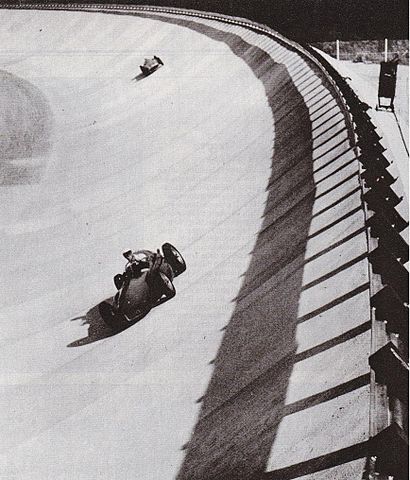Precalculus by Richard Wright
Precalculus by Richard Wright
Start children off on the way they should go, and even when they are old they will not turn from it. Proverbs 22:6 NIV
Summary: In this section, you will:
SDA NAD Content Standards (2018): PC.5.1

Trigonometric identities can be used to simplify expressions. For example, figure 1 shows a banked curve of a racetrack. Banked curves are designed to eliminate the need for friction to turn the car at a given speed. The equations modeling the banked curve are
$$F_N \sin θ = \frac{mv^{2}}{r}$$
\(F_N \cos θ = mg\)
Trigonometric identities simplify these equations into
$$\tan θ = \frac{v^2}{gr}$$
There are four main uses of trigonometric identities.
Reciprocal Identities
| \(\sin u = \frac{1}{\csc u}\) | \(\csc u = \frac{1}{\sin u}\) |
| \(\cos u = \frac{1}{\sec u}\) | \(\sec u = \frac{1}{\cos u}\) |
| \(\tan u = \frac{1}{\cot u}\) | \(\cot u = \frac{1}{\tan u}\) |
Quotient Identities
| \(\tan u = \frac{\sin u}{\cos u}\) | \(\cot u = \frac{\cos u}{\sin u}\) |
Pythagorean Identities
| \(\sin^{2} u + \cos^{2} u = 1\) |
| \(\tan^{2} u + 1 = \sec^{2} u\) |
| \(1 + \cot^{2} u = \csc^{2} u\) |
Even/Odd Identities
| Even | |
| cos(–u) = cos u | sec(–u) = sec u |
| Odd | |
| sin(–u) = –sin u | csc(–u) = –csc u |
| tan(–u) = –tan u | cot(–u) = –cot u |
Cofunction Identities
| \(\sin \left(\frac{π}{2} - u\right) = \cos u\) | \(\cos \left(\frac{π}{2} - u\right) = \sin u\) |
| \(\tan \left(\frac{π}{2} - u\right) = \cot u\) | \(\cot \left(\frac{π}{2} - u\right) = \tan u\) |
| \(\sec \left(\frac{π}{2} - u\right) = \csc u\) | \(\csc \left(\frac{π}{2} - u\right) = \sec u\) |
To evaluate trigonometric expressions using identities, replace a complicated expression with a simpler one. If there is more than one trigonometric function in the expression, try to replace them with a single function. Repeat this until the functions are simple to evaluate.
Try
If \(\cos α = \frac{4}{5}\) and tan α < 0, evaluate a) sin α and b) cot α.
Solution
Because cosine > 0 and tangent < 0, angle α is in quadrant IV and the signs of the trigonometric functions should be for that quadrant (see Lesson 4-05).
An identity relating cos α and sin α is a Pythagorean Identity.
| \(\sin^2 α + \cos^2 α = 1\) |
| \(\sin^2 α + \left(\frac{4}{5}\right)^2 = 1\) |
| \(\sin^2 α = \frac{9}{25}\) |
| \(\sin α = ±\frac{3}{5}\) |
Since sine is negative in quadrant IV, \(\sin α = -\frac{3}{5}\).
A quotient identity relates cotangent with cosine and sine.
| \(\cot α = \frac{\cos α}{\sin α}\) |
| \(\cot α = \frac{\frac{4}{5}}{-\frac{3}{5}}\) |
| \(\cot α = -\frac{4}{3}\) |
If \(\tan θ = -\frac{5}{6}\) and \(\sin θ = \frac{\sqrt{61}}{5}\), find a) cos θ and b) csc θ.
Solution
Because tangent < 0 and sine > 0, angle θ is in quadrant II and the signs of the trigonometric functions should be for that quadrant.
A quotient identity relates tan θ, sin θ, and cos θ.
| \(\tan θ = \frac{\sin θ}{\cos θ}\) |
| \(-\frac{5}{6} = \frac{\frac{\sqrt{61}}{5}}{\cos θ}\) |
| \(\cos θ = \frac{\frac{\sqrt{61}}{5}}{-\frac{5}{6}}\) |
| \(\cos θ = -\frac{6\sqrt{61}}{25}\) |
A reciprocal identity relates sin θ and csc θ
| \(\csc θ = \frac{1}{\sin θ}\) |
| \(\csc θ = \frac{1}{\frac{\sqrt{61}}{5}}\) |
| \(\csc θ = \frac{5\sqrt{61}}{61}\) |
If \(\sin θ = -\frac{24}{25}\) and cos θ < 0, find a) cos θ and b) cot θ.
Answer
\(-\frac{7}{25}, \frac{7}{24}\)
Simplify \(\cos x \tan^{2} x + \cos x\).
Solution
Notice that there is a cos x each term. Factor out the cos x.
| \(\cos x \tan^2 x + \cos x\) |
| \(\left(\cos x\right)\left(\tan^2 x + 1\right)\) |
A Pythagorean identity is \(\tan^2 u + 1 = \sec^2 u\), so substitute sec2 x for \(\left(\tan^2 x + 1\right)\).
$$\cos x \sec^2 x$$
A reciprocal identity allows sec x to be written as \(\frac{1}{\cos x}\).
| \(\cos x \frac{1}{\cos^2 x}\) |
| \(\frac{1}{\cos x}\) |
| \(\sec x\) |
Simplify \(\cos\left(\frac{π}{2} - x\right) \csc\left(–x\right)\).
Solution
A cofunction identity says \(\cos\left(\frac{π}{2} - x\right) = \sin x\).
| \(\cos\left(\frac{π}{2} - x\right)\csc\left(–x\right)\) |
| \(\sin x \csc\left(–x\right)\) |
An even/odd identity says \(\csc\left(–x\right) = -\csc x\).
$$\sin x \left(-\csc x\right)$$
A reciprocal identity says \(\csc x = \frac{1}{\sin x}\).
$$\sin x \left(-\frac{1}{\sin x}\right)$$
–1
Simplify \(\sec x - \sec x \sin^2 x\).
Answers
cos x
Reciprocal Identities
| \(\sin u = \frac{1}{\csc u}\) | \(\csc u = \frac{1}{\sin u}\) |
| \(\cos u = \frac{1}{\sec u}\) | \(\sec u = \frac{1}{\cos u}\) |
| \(\tan u = \frac{1}{\cot u}\) | \(\cot u = \frac{1}{\tan u}\) |
Quotient Identities
| \(\tan u = \frac{\sin u}{\cos u}\) | \(\cot u = \frac{\cos u}{\sin u}\) |
Pythagorean Identities
| \(\sin^{2} u + \cos^{2} u = 1\) |
| \(\tan^{2} u + 1 = \sec^{2} u\) |
| \(1 + \cot^{2} u = \csc^{2} u\) |
Even/Odd Identities
| Even | |
| cos(–u) = cos u | sec(–u) = sec u |
| Odd | |
| sin(–u) = –sin u | csc(–u) = –csc u |
| tan(–u) = –tan u | cot(–u) = –cot u |
Cofunction Identities
| \(\sin \left(\frac{π}{2} - u\right) = \cos u\) | \(\cos \left(\frac{π}{2} - u\right) = \sin u\) |
| \(\tan \left(\frac{π}{2} - u\right) = \cot u\) | \(\cot \left(\frac{π}{2} - u\right) = \tan u\) |
| \(\sec \left(\frac{π}{2} - u\right) = \csc u\) | \(\csc \left(\frac{π}{2} - u\right) = \sec u\) |
Try
Helpful videos about this lesson.
| (a) \(2\sin^2 x - 1\) | (b) sin x |
| (c) sec x | (d) cos x |
| (e) csc x | (f) tan x |